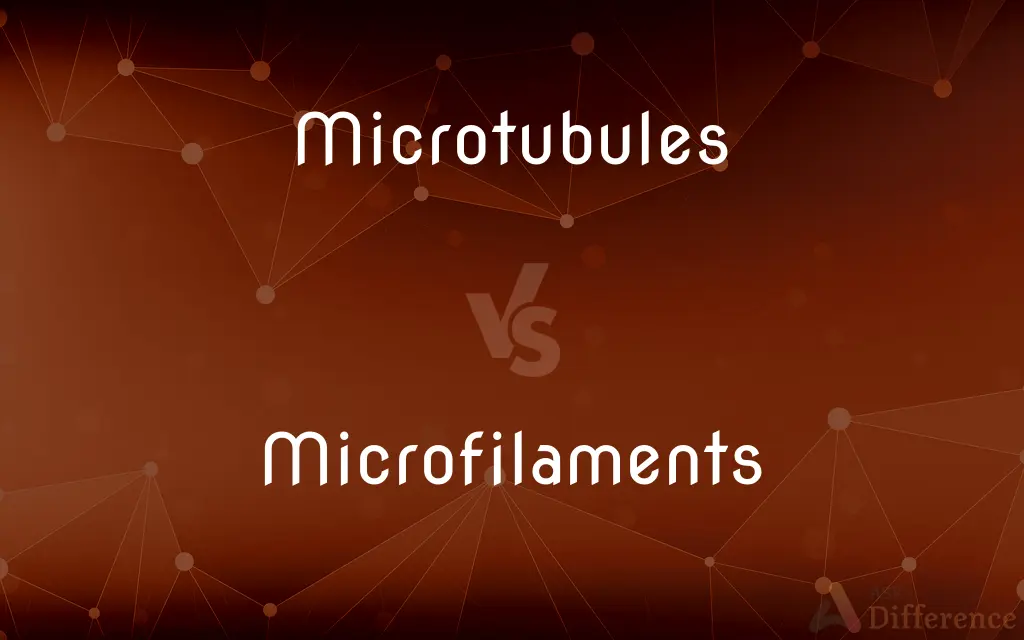Microtubules vs. Microfilaments — What's the Difference?
By Tayyaba Rehman — Published on November 24, 2023
Microtubules are tubular structures composed of tubulin, providing cellular support. Microfilaments, made of actin, are involved in cell movement and shape.

Difference Between Microtubules and Microfilaments
Table of Contents
ADVERTISEMENT
Key Differences
Microtubules are cylindrical tubes found in the cytoplasm of eukaryotic cells, playing a role in maintaining cell shape and structure. Conversely, Microfilaments are thinner, thread-like structures predominantly composed of the protein actin and are responsible for many types of cellular movements.
Microtubules, composed of tubulin proteins, serve as tracks for the intracellular movement of substances. Microfilaments, being actin filaments, often work with another protein called myosin to enable muscle contraction and other movement-related activities.
In terms of cellular functions, Microtubules are vital for processes like mitosis, where they form the mitotic spindle helping in chromosome separation. On the other hand, Microfilaments facilitate processes like cell division (cytokinesis) where they pinch the cell into two.
Microtubules are also central components of structures like cilia and flagella, aiding cell movement. Microfilaments, with their dynamic assembly and disassembly, play a significant role in changing the cell's shape and in phenomena like cellular crawling.
The stability factor also distinguishes the two. Microtubules can be more dynamic, rapidly assembling and disassembling as needed by the cell. Microfilaments, while also dynamic, provide more consistent tension and support, especially near the cell's periphery.
ADVERTISEMENT
Comparison Chart
Primary Composition
Tubulin
Actin
Function in Cell
Provide structural support
Involved in movement and shape
Associated Cellular Processes
Mitosis, intracellular transport
Muscle contraction, cell division, shape change
Appearance
Tubular structures
Thinner, thread-like structures
Structures They Form
Part of cilia, flagella
Often associated with myosin in muscles
Compare with Definitions
Microtubules
Cellular components providing structural support.
The integrity of the cell's shape is often maintained by Microtubules.
Microfilaments
Thin, thread-like cellular structures primarily made of actin.
Microfilaments play a central role in muscle cells, enabling contraction.
Microtubules
Cylindrical structures in cells composed of tubulin proteins.
During cell division, Microtubules form the mitotic spindle, helping in chromosome alignment.
Microfilaments
Assemblies providing tension and support in cells.
Near the cell's edge, a network of Microfilaments provides the necessary tension for shape maintenance.
Microtubules
Intracellular tracks facilitating movement of substances.
Motor proteins walk along Microtubules, transporting vesicles within the cell.
Microfilaments
Components crucial for cell movement and shape.
The crawling movement of certain cells is driven by the dynamic nature of Microfilaments.
Microtubules
Dynamic assemblies that rapidly form or disassemble.
Upon certain signals, Microtubules can rapidly rearrange to support cellular processes.
Microfilaments
Actin filaments interacting with myosin in muscles.
The interaction between Microfilaments and myosin results in the sliding mechanism of muscle contraction.
Microtubules
Key components of cilia and flagella in cells.
The beating of cilia, facilitated by Microtubules, helps in moving substances over cell surfaces.
Microfilaments
Essential for processes like cytokinesis in cell division.
During cell division, Microfilaments constrict and help split the cell into two daughter cells.
Microtubules
Any of the cylindrical hollow tubulin-containing structures that are found in the cytoplasm, cilia, and flagella of eukaryotic cells and are involved in determining cell shape and structure and directing the movement of organelles and chromosomes. Microtubules, along with microfilaments and intermediate filaments, make up a cell's cytoskeleton.
Microfilaments
Any of the actin-containing filaments that are found in the cytoplasm of eukaryotic cells and are involved in generating cell movement, providing structural support, and organizing internal cell components. Microfilaments, along with intermediate filaments and microtubules, make up a cell's cytoskeleton.
Microtubules
Plural of microtubule
Microfilaments
Plural of microfilament
Common Curiosities
Do Microtubules play a role in cell movement?
Yes, Microtubules form structures like cilia and flagella, which aid in cell movement.
Are Microtubules involved in chromosome separation?
Yes, during mitosis, Microtubules form the mitotic spindle, aiding in chromosome separation.
How do Microfilaments aid in muscle contraction?
Microfilaments, composed of actin, interact with myosin to enable muscle contraction.
What are Microtubules primarily composed of?
Microtubules are primarily composed of tubulin proteins.
Can Microfilaments change the shape of the cell?
Yes, through their dynamic assembly and disassembly, Microfilaments can change the cell's shape.
How do Microfilaments aid in cell division?
Microfilaments facilitate cytokinesis, helping pinch and split the cell into two.
Are Microtubules found in all cells?
Microtubules are found in eukaryotic cells, not in prokaryotic cells.
What structures do Microtubules form in cells?
Microtubules form structures like the mitotic spindle, cilia, and flagella.
How do Microfilaments contribute to cellular crawling?
Microfilaments, with their dynamic assembly, allow cell extensions and retractions, enabling crawling.
What protein predominantly makes up Microfilaments?
Microfilaments are predominantly made of actin.
Are Microtubules static structures?
No, Microtubules are dynamic and can rapidly assemble and disassemble as needed by the cell.
Do Microfilaments have a role in cellular transport?
Microfilaments primarily influence cell shape and movement, while Microtubules play a more direct role in transport.
Can cells function without Microtubules or Microfilaments?
Both are vital for various cellular processes, and their absence or malfunction can hinder cell function.
Which is thicker, Microtubules or Microfilaments?
Microtubules are thicker compared to the thinner Microfilaments.
What cellular processes involve Microfilaments?
Microfilaments are involved in muscle contraction, cell movement, cytokinesis, and shape maintenance.
Share Your Discovery

Previous Comparison
Line of Control vs. International Border
Next Comparison
Angle of Friction vs. Angle of ReposeAuthor Spotlight
Written by
Tayyaba RehmanTayyaba Rehman is a distinguished writer, currently serving as a primary contributor to askdifference.com. As a researcher in semantics and etymology, Tayyaba's passion for the complexity of languages and their distinctions has found a perfect home on the platform. Tayyaba delves into the intricacies of language, distinguishing between commonly confused words and phrases, thereby providing clarity for readers worldwide.
















































